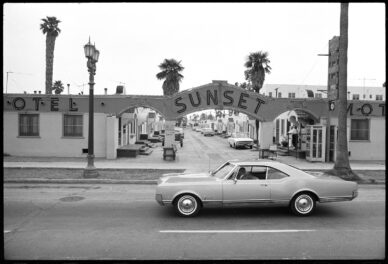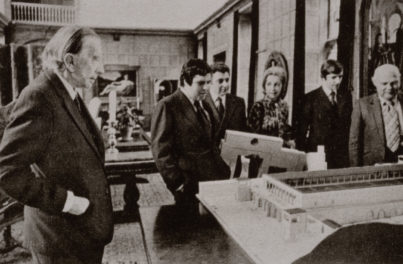
City Whispers, Philadelphia, 1982, Ray K. Metzker. Gelatin silver print, 7 3/4 x 12 in. The J. Paul Getty Museum, 2012.27.5 © Ray K. Metzker
The exhibition The Photographs of Ray K. Metzker and the Institute of Design, on view for a few more days, continues to win me over in subtle ways. Metzker’s relatively unknown photographs may at first glance seem mundane, but they’re complex meditations on modern city life that have surprisingly become some of my favorite 20th-century photographs.
Among my favorite aspects of Metzker’s photographs is their cinematic quality. His Composites, from a certain distance, invoke experimental video, while many of his street photographs suggest film noir. Of course, I’m not the only one picking up the film noir vibes; Jennifer Mangin, a Getty visitor, beautifully describes Metzker’s photograph of a bus stop from the City Whispers series:
None of them seem to be interacting—it looks as if all of them are there by themselves, catching the bus, not with a friend, but with their own being. The lighting again gives this photograph an eerie film, quite like a film noir. The people are different and yet the long shadows give everyone the feeling of being the same. They don’t realize that they are all feeling the same alienation, but they are.
Personally, I’ve really gotten a kick out of imagining the people in Metzker’s photographs as supporting characters in a film noir—captured on an average day, precisely at the loneliest moment before the cruel twist of fate takes hold. A moment that has more to do with the darkness of mood and tone than with the aesthetic of black and white, shadows and light.

City Whispers: Los Angeles, negative 1981; print 2006, Ray K. Metzker. Gelatin silver print, 10 9/16 x 16 5/16 in. The Nelson-Atkins Museum of Art, Gift of the Hall Family Foundation, 2009.6.25. © Ray K. Metzker
Metzker’s photographs share a sense of gloom and mystery with some of the best midcentury film noir—the difference being that the films have the benefit of expanding the story, twisting a little tighter, and maybe a cheap smoke machine or two. Film noir lingers in the shadows a bit longer, as noirist Eddie Muller describes:
Film noir is the flip side of the all-American success story. It’s about people who realize that following the program will never get them what they crave. So they cross the line, commit a crime, and reap the consequences. Or, they’re tales about seemingly innocent people tortured by paranoia and ass-kicked by Fate. Either way, they depict a world that’s merciless and unforgiving.

City Whispers, Chicago, 1982, Ray K. Metzker. Gelatin silver print, 7 13/16 x 11 15/16 in. The J. Paul Getty Museum, 2012.27.4 © Ray K. Metzker
Both Metzker’s photographs and film noir are reminders that sometimes you have to obscure, to whisper, to get your point across. Prompted by Metzker, I’ve recently been re-watching some of my favorite film noir. Here are a couple “street” noirs worth dimming the lights for.
Pickup on South Street (1953)

Still from Pickup on South Street (1953). The Criterion Collection
In Pickup on South Street, a pickpocket picks the wrong pocket and finds himself thrust between federal agents, hired Commie guns, and a girl named Candy. Through a mishmash of New York City contradictions, punches, and bullets, the film never lets up the pace, nor gets too bogged down in its Cold War politics.
Instead, it digs deeper and looks at the true, all-too-human motivations of crooked acts. But, I’ll let the director—the one and only Samuel Fuller—expand on that, along with what it was like to have J. Edgar Hoover tell him he didn’t like the film.
Scarlet Street (1945)

Still from Scarlet Street (1945)
Fritz Lang’s Scarlet Street is not only one of my favorite noirs, it’s also one of my favorite films dealing with shifting perspectives on art and the business of art. Edward G. Robinson plays an older, demoralized clerk with amateur artistic ambitions on the weekend who lets delusion and jealous rage—courtesy of gorgeous femme fatale Joan Bennett—get the best of him. This film brilliantly depicts the inescapable tortures of the mind.

Joan Bennett and Edward G. Robinson in The Woman in the Window (1944) Photo: MGM
If you like this one, you might also consider the equally good The Woman in the Window(1944), which features the same director and cast, at a different angle.
Metzker, followed by some film noir? A highly recommended double feature.




Comments on this post are now closed.